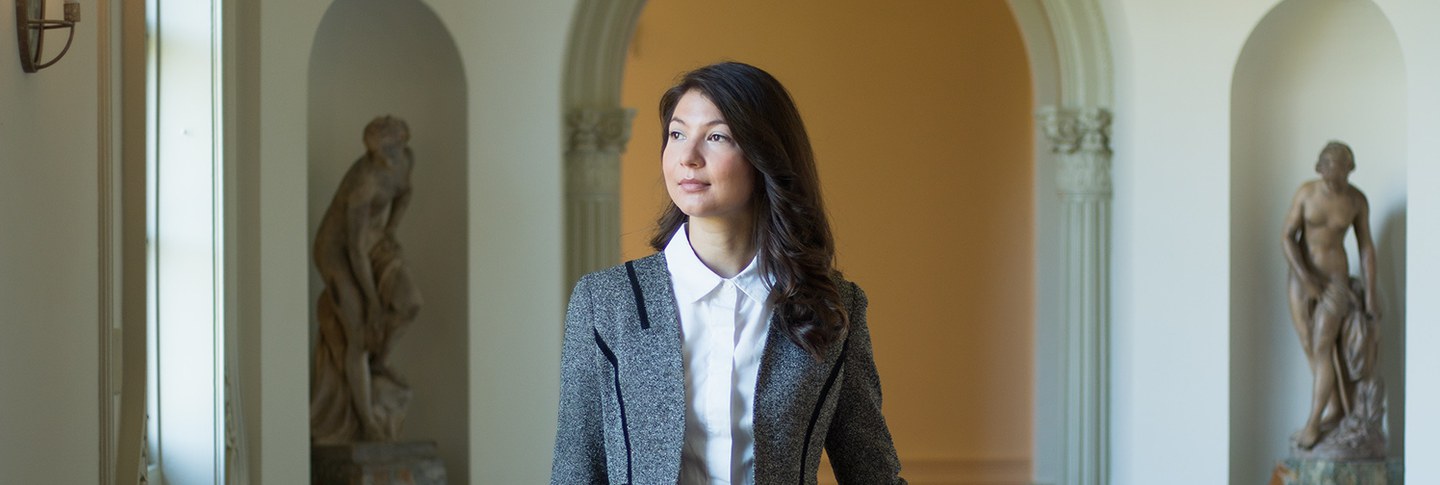Michelle Young, adjunct faculty in history and art history at George Mason University, was a 2019–2020 junior fellow in Pre-Columbian Studies. Her research report, “The ‘Chavín Phenomenon’ in Huancavelica, Peru: Interregional Interaction, Ritual Practice, and Social Transformation at Atalla,” examined how exchange networks and shared religious systems contributed to the development of civilization in the Andes.
Q&A with Michelle Young
So, what is the “Chavín Phenomenon?”
Chavín was a cultural and artistic phenomenon that emerged between 900 and 500 BCE throughout much of what is now Peru. As the earliest widespread civilization in the Andes, Chavín is of great interest to archaeologists. In fact, there was a conference at Dumbarton Oaks in 2018 that focused on our new understandings of this topic, titled Reconsidering the Chavín Phenomenon in the 21st Century.
The Chavín Phenomenon is characterized by certain types of iconography and ceramics and by megalithic temples that were connected through long-distance trade networks. The rich, complex, and striking iconography in the Chavín style is mythological or supernatural, pointing to the phenomenon having a religious element.
What evidence have you found that a shared religious tradition was part of the Chavín Phenomenon? How does your research expand our understanding of the phenomenon?
I directed excavations at Atalla, on the southernmost edge of the area that participated in the Chavín Phenomenon. I determined that the site was occupied intermittently beginning around 1150 BCE by a small pastoral community, but by 900 BCE it had grown into the largest sedentary village in the Huancavelica region. Sometime between 900 and 800 BCE, residents constructed a large temple that in many respects emulates the architectural techniques at Chavín de Huántar and other megalithic temple sites in the Chavín network.
The correspondence in art, architecture, and ritual practice between Atalla and other megalithic temple centers indicates there was widespread participation in ceremonies that emphasized shamanic transformation with the aid of hallucinogens. At Atalla we found snuffing implements (tubes and spatulas) that suggest people were inhaling hallucinogenic snuff in similar ways to what we see depicted in a sculpture at Chavín de Huántar. Dumbarton Oaks holds a delicately wrought gold and silver snuff spoon made in the Chavín style showing a shaman or priest, which would have been used for such a purpose.
Archaeological and art historical evidence suggests that within the larger system of ideologies and religious practices, distinct regional cults also flourished. Temples like Limoncarro and iconography on carved stone—like the remarkable Cupisnique steatite vessel and plate in the Dumbarton Oaks collection—illustrate the existence of a spider deity cult indigenous to the Peruvian north coast.
My research introduces a much more nuanced, layered understanding of Chavín. Through a close examination of ceramics at Atalla, I came to two major conclusions. The first is that Chavín-style ceramics are limited to specific vessel shapes: finely made bottles and bowls, often with pouring lips. This suggests the Chavín style was used for ritual equipment in ceremonies that emphasized serving and drinking specialized beverages. The second realization was that these ceramics don’t directly emulate the assemblage from Chavín de Huántar, the “type site” for the Chavín Phenomenon. In fact, they are much more similar to Chavín-style ceramics from neighboring regions. This suggests a decentralized model for the spread of this phenomenon. Regional variation and the timing of different elements (architecture, ceramics, trade goods) being introduced—which I consider closely—are parts of the conversation that had been missing in some of our discussions around Chavín.
The Plant Humanities Initiative investigates the significance of plants to human culture. How does your work engage with this theme?
Plants were extremely important to the religious practices and beliefs of people across the Americas.
At Atalla, fragments of finely made cactus-shaped cups appeared in our excavations of the temple. Worshipers would have consumed from these vessels a sacramental brew made from San Pedro cactus, also known as huachuma, a hallucinogenic plant still used in shamanistic curing ceremonies in Peru today. Indigenous Andean belief systems consider sacred plants like huachuma living beings with their own personalities and life forces.
Researchers have also previously highlighted the importance of vilca (also called yopo), a hallucinogenic snuff made from seedpods. When the Spanish came to Peru in the sixteenth century, they wrote accounts of sorcerers using vilcanas, beautiful mortars for grinding snuff. We believe similar mortars and evidence of snuff use at Chavín sites may be the predecessors to what the Spanish encountered. Yopo comes from the eastern lowlands and huachuma comes from the highlands, but evidence for the use of both these plants is found outside their natural growing regions, suggesting a high degree of interconnectivity between these ecological zones. This also demonstrates that one of the impetuses for the development of civilization was trading not just exotic luxury goods, but also important plant resources.
Julia Ostmann is postgraduate writing and reporting fellow at Dumbarton Oaks. Photo by Elizabeth Muñoz Huber, postgraduate digital media fellow.

